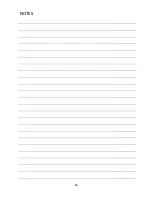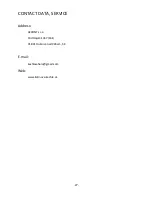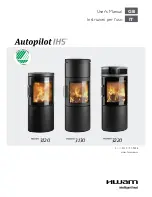
-14-
THE STOVE OPERATION AT REDUCED POWER
The stove may be operated for longer time period at the reduced power. When the
stove is reasonably heated up and the layer of loaded wood burns out, clean the grill by shifting
while holding the grip (Fig. 1 - position c) and let just the hot coals on the grill forming a layer of
one up to two centimetres height. The ash-can door (Fig. 1 - position b) must be completely
closed. Open the loading door (Fig. 1 - position a) and load the maximum amount of fuel to the
combustion area (as much as can be put inside, approx. 6 kg) - dry hardwood in horizontal,
askew or vertical position (the vertical position of wood is recommended in particular near the
window so that the loaded wood would not obstruct the glass when closing the door). Well
stacked wood in the combustion area is the precondition of a long combustion per one fuel
loading. Duly close the loading door (Fig. 1 - position a). After a short reasonable time, when the
loaded fuel starts burning (the primary and secondary air control should be set to maximum),
set the control for the adjustment of the primary air (Fig. 1 - position d) to the minimum
position. The secondary air control (Fig. 1 position e) should be moved gradually from the
maximum position to the minimum position, monitor the flame through the loading door.
When the flame is small and looks like it would soon stop burning, terminate the adjustment of
secondary air (Fig. 1 - position e). Such heated up stove can heat for approx. 12 hours depending
on the type of the stove, heating and weather conditions. The fuel doses shall be combusted in
an efficient way for a long time without any external intervention.
As long as you want to interrupt the above described process and transfer to the intensive
heating, set the regulation controls of the primary and secondary air according to the stove
operation to the nominal power.
STOVE OPERATION TERMINATION
As long as the fuel in the stove got burned out and you do not want to continue with
heating, set all the regulation controls to minimum (Fig. 1 - position d, e). Thus you shall reduce
the supply of combustion air to the allowable minimum. In addition, the outlet of chimney
products shall be reduced to minimum, whereby the heat leakage through the chimney shall be
mitigated, and completely close the ash-can door (Fig. 1 - position b). The accumulation mass
(crashed glass) poured at the sides of the ash-can shall release the saved heat to the
surrounding area even after the stove went completely out.
Should any surface external parts of the stove got red heated when
heating intensively, immediately set the supply of primary sucking air to
minimum, nothing special happens, everything is OK, you can continue
heating. Of course, while observing all fire and safety regulations as well
as the Operation Manual supplied by the manufacturer of the stove. The
shade of the surface treatment of the stove can change after it cools
down, which is allowable.















































